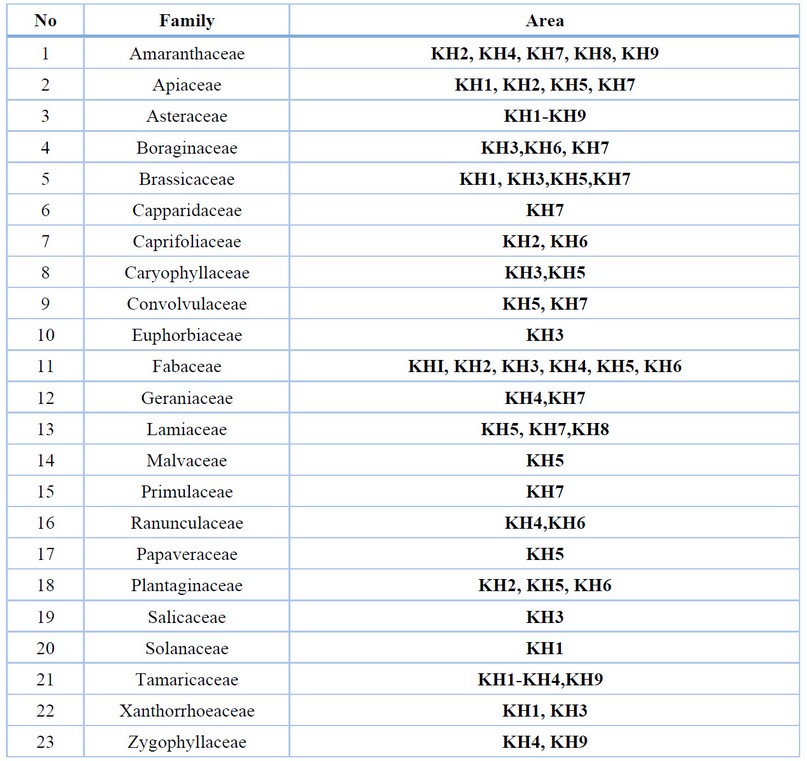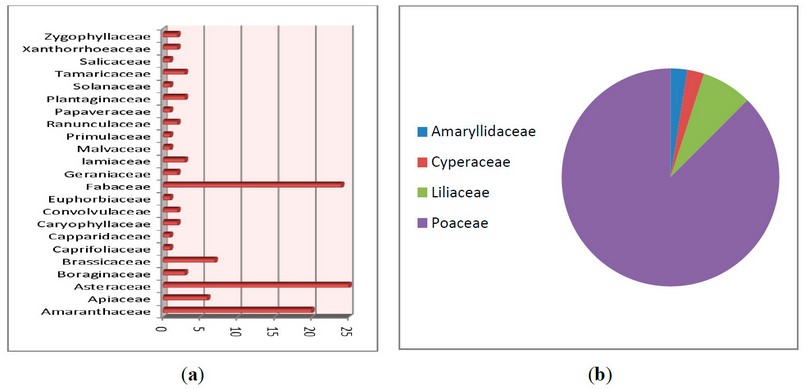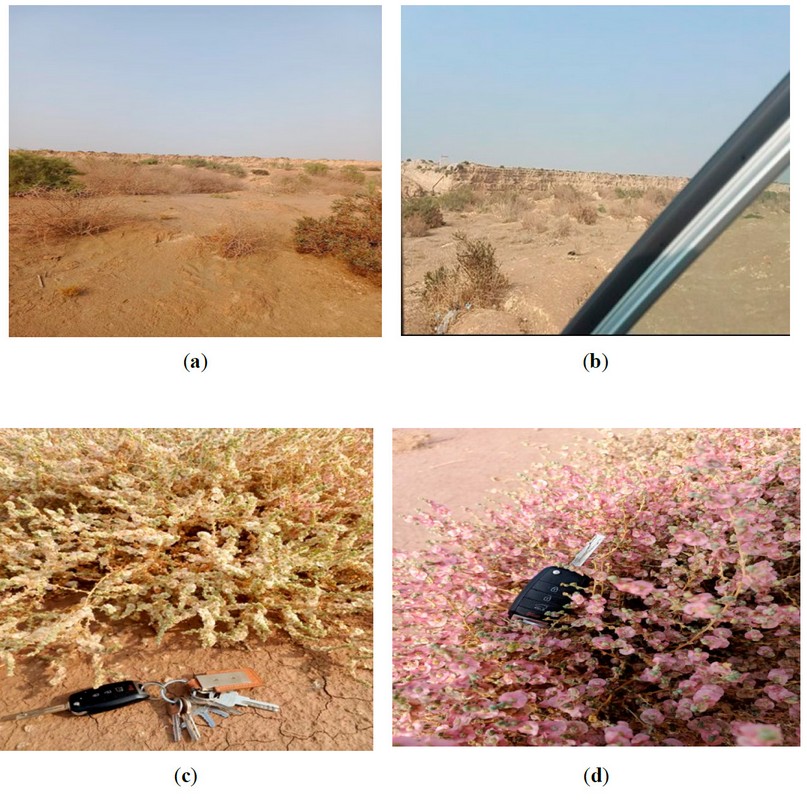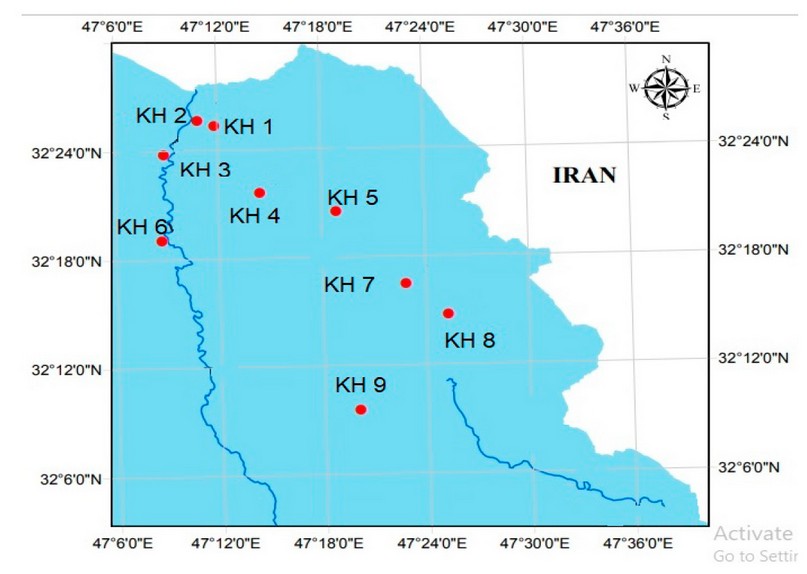2023.08.03.106
Files > Volume 8 > Vol 8 No 3 2023
Geological and Plant Diversity in Selected Areas of Al Tib, Maysan, Iraq
1 Iraq Natural History Research Center and Museum, University of Baghdad, Iraq. [email protected].
2 Department of Geology, College of Science, Baghdad University, Baghdad, Iraq. [email protected]
* Correspondence: [email protected]
Available from: http://dx.doi.org/10.21931/RB/2023.08.03.106
ABSTRACT
The study was conducted in Al-Tib, Maysan, Iraq, through field trips to learn about the plant diversity and the surrounding conditions in these areas. The study area was characterized by a distinctive plant diversity that varies from one area to another. It was found that these plants belong to many plant families, both dicotyledonous and monocotyledonous plants, including Amaranthaceae, Apiaceae, Asteraceae, Boraginaceae, Brassicaceae, Capparidaceae, Caprifoliaceae, Caryophyllaceae, Convolvulaceae, Euphorbiaceae, Fabaceae, Geraniaceae, Lamiaceae, Malvaceae, Papaveraceae, Plantaginaceae, Primulaceae, Salicaceae, Ranunculaceae, Solanaceae, Tamaricaceae, Xanthorrhoeaceae and Zygophyllaceae, 39 of monocotyledonous plants belong to the families: Amaryllidaceae, Cyperaceae and Poaceae.
Keywords: Al Tib, Diversity, Iraq, Maysan, Plant.
INTRODUCTION
Like other countries in the Middle East and elsewhere, Iraq is differentiated into 2 societies: rural and urban. Iraq is famous for its great diversity of wild plants depending on geographical diversity and climate conditions. One of Iraq's most essential and diverse physiographic regions is the Upper Plains and Foothills Region. This region is divided into five districts. The eastern district that runs along the Persian border southwardly to Tib at Amara province is called the Persian Foothills District (FPF)². The FPF, which has Jabal Hamrin, is characterized by great diversity in plants and animals. The Introduction to Iraqi Flora, Volume One, accounts for Iraq's geology, topography, climate, soil, and environment. She also described the vegetation and phytogeographic subdivision in Iraq³. This region and its neighboring regions are distinguished by the soils characterized by the diversity of sands of soft quality to compact gravel sands or sometimes clay. Vegetation varies according to seasonal soil moisture, which depends on time, amount and season of rain4,5.
The area is characteristic and exciting in spring and dominated by many annual and perennial herbs, while in Summer and Autumn, nearly all the annuals die. In general, the area in Autumn is dominated by shrubs or bushes, rarely trees of closed communities, and sometimes halophytes8,9.
The study aims to determine the plant diversity in these regions, the density of plants and their distribution in each area in terms of plant abundance and lack of plants, and the environmental conditions surrounding each location.
MATERIALS AND METHODS
Samples collection
The samples were collected through field trips to Al Tib, Maysan, in 2022. It was divided into small areas: K.H. 1, K.H. 2, KH3, KH4, KH5, KH6, KH7, K.H. 8, and K.H. 9, which was chosen randomly to determine the plant diversity in those areas that are characterized by biodiversity in all aspects to study the plant diversity as well as soil characteristics and surround environmental conditions. Plant samples were diagnosed at the family level in the Plant and Environment Laboratory at the Iraq Natural History Research Center and Museum, University of Baghdad, Iraq. The author analyzed These specimens and some taxonomic keys, for example, 10,11,12.
RESULTS
Al Tib is considered one of the critical areas in Iraq because it is a tourist area with a distinctive geographical environment. It was also chosen for study because there are few studies on these areas. It was found that the Asteraceae family species are among the most widespread and tolerant of the environmental conditions in those areas.
The results of this study recorded 114 plant species of dicotyledons which belong to the plant families such as Amaranthaceae, Apiaceae, Asteraceae, Boraginaceae, Brassicaceae, Capparidaceae, Caprifoliaceae, Caryophyllaceae, Convolvulaceae, Euphorbiaceae, Fabaceae, Geraniaceae, Lamiaceae, Malvaceae, Papaveraceae, Plantaginaceae, Primulaceae, Salicaceae, Ranunculaceae, Solanaceae, Tamaricaceae, Xanthorrhoeaceae and Zygophyllaceae, 39 of monocotyledonous plants belong to the families: Amaryllidaceae, Cyperaceae and Poaceae. (Table 1) (Fig. 1).
1- KH1: 32°25'45.3"N 47°09'46.1"E: This area is between the Al Tib River and the Ghulam district in the Al-Tib region. The region was characterized by the spread of dicotyledonous plants, especially the family Amaranthaceae, which were the most common species in that region, as well as monocotyledonous plants, which included Amaryllidaceae, Cyperaceae, Liliaceae and Poaceae, It was noted from the collected and diagnosed plants that the family Poaceae is the most numerous and widespread in that region.
2- KH2: 32°25'45.9"N 47°09'42.5"E: This area was chosen randomly. It is on the banks of the Al-Tib River and is characterized as one of the most diverse study areas. It is more than the previous area in the number of plant families and the abundance of plants, and the reason for this is due to the fertility of the soil consisting of mud or sand and the availability of a water source. However, it was noted that the Asteraceae family is the most diverse and widespread in this region concerning dicotyledonous plants.
3- KH3: 32°25'36.5"N 47°09'32.6"E: This area is also located on the banks of the Al-Tib River, at a distance from the previous area, and the diversity of plants also distinguished it due to the availability of water source in that area. It was noted that the Fabaceae family is the most abundant and widespread, as well as monocotyledonous plants, which only included Cyperaceae and Poaceae.
4- KH4: 32°25'36.8"N 47°09'56.2"E: This region was characterized by an effortless diversity in the number of plants because the type of soil may not suit the needs of the plants, and also the lack of water that depends only on rainwater.
5- KH5: 32°22'50.8"N 47°19'13.4"E: This area is located near the Zubaidat area, which is very famous for the plant diversity of many plant families, which were characterized by the spread of their numbers due to the availability of all appropriate environmental conditions such as rain and suitable soil.
6- KH6: 32°16'24.3"N 47°08'29.7"E: This area is located near the shrine of Sayed Youssef, and this is also characterized by simple plant diversity, perhaps because it is an area settled by people, which led to a lack of plants in that area. However, it was noted that the Poaceae family spread a lot.
7- KH7: 32°20'34.3"N 47°21'10.3"E: After the previous one, this area is further away from the Zubaidat area towards the Tib River. The diversity of distinctive plants in clusters or individually also characterizes this area.
8- KH8: 32°17'12.7"N 47°24'50.3"E: This area is near a place called Abu Gharb, and it was also characterized by simple plant diversity in the form of clusters at far distances from each other.
9- KH9: 32°08'34.0"N 47°16'45.8"E: This region was also characterized by a lack of plants. Bue presence of the two species was observed in large and clear, and some of them were in the flowering period and others in the fruiting period: Caroxylon jordanicola (Eig) Akhani & Roalson and Halothamnus iraqensis Botsch belonging to Amaranthaceae family. The prevalence of these two species was distinctive in that region (Fig. 2,3).

Table 1. Distribution of plant families in the study areas

Figure 1. a: Shows dicotyledonous families, b: Shows monocotyledonous families

Figure 2. a: Shows KH4 area and lake of plants, b: KH8 explains the nature of the soil,
c: Halothamnus iraqensis Botsch d: Caroxylon jordanicola (Eig) Akhani & Roalson

Figure 3. Geographical distribution of the study areas
DISCUSSION
The variation in plant diversity distinguished the study areas, as they were very diverse in some. In contrast, others were less diverse, and this may be due to reasons related to their proximity to water sources, soil type, or other reasons. It was also noted, after diagnosing all the plants, monocotyledonous (Fig. 5) and dicotyledonous plants (Fig. 6) that were collected from those areas (Fig 7), that the Asteraceae family is the most diverse in the number of its species, this is because the species of this family are the most able to withstand challenging environmental conditions such as lack of water and soil salinity13,14, so the species are found thriving and present as groups or as individuals spreading over close distances from each other, which is one of the characteristics that characterize most areas similar to this region, even when studying areas with less plant diversity found Species of this family are thriving in those areas15,16. The same is the case with the family followed by the family, whose species were observed in all the studied environments but were less than the previous ones in the number of species. Some plant families have recorded their presence in these areas through one species per family, such as Caprifoliaceae, Capparidaceae, Euphorbiaceae, Solanaceae, Malvaceae and Primulaceae, Papaveraceae, Solanaceae and Salicaceae. Among the observations that were recorded is that the plant family, which we mentioned, was characterized by the presence of only one species, and it was noted that in some areas, it reaches a great height. This may be due to the harmony of the plant with its surrounding environment and the nutrients. That the plant needs for growth17,18,19.
It is worth noting that no type of gymnosperm plants was recorded in those areas, and this differed from what was recorded by other researchers, as they noticed the presence of gymnosperm plants in places of the study different from the places that were dealt with in our study.
CONCLUSIONS
The study was conducted in Al-Tib areas to discover the many plant diversity, considered one of Iraq's critical areas because it is a tourist area with a distinctive geographical environment. It was also chosen for study because there are few studies on these areas. It was found that the Asteraceae family species are among the most widespread and tolerant of the environmental conditions in those areas. Al-Tib areas have 114 plant species of dicotyledons belonging to plant families: Amaranthaceae, Asteraceae, Fabaceae, Apiaceae, Brassicaceae, Zygophyllaceae, Caryophyllaceae, Euphorbiaceae, Solanaceae, Primulaceae, Boraginaceae, Plantaginaceae, Salicaceae, Lamiaceae, Convolvulaceae, Ranunculaceae, Capparidaceae, Geraniaceae, Malvaceae, Papaveraceae, Xanthorrhoeaceae, Tamaricaceae, Caprifoliaceae, and 39 of monocotyledonous plants belong to the families: Amaryllidaceae, Cyperaceae, Liliaceae and Poaceae. The study also focused on the number of plant families, how they spread and distributed, and the differences in the randomly selected areas for the study in the distribution of plant families there. The beauty of nature characterizes the Al-Tib areas, and the plants abound; it was noted that some selected areas are thriving with plants, which are densely located and in huge numbers.
Author Contributions: Conceptualization, X.X. and Y.Y.; methodology, X.X.; software, X.X.; validation, Y.Y.; formal analysis, X.X. and Y.Y.; investigation, X.X.; resources, X.X.; data curation, X.X. and Y.Y.; writing—original draft preparation, X.X.; writing—review and editing, X.X.; visualization, X.X.; supervision, X.X.; project administration, X.X.; funding acquisition, Y.Y.
Funding: "This research received no external funding".
Institutional Review Board Statement: "Not applicable."
Informed Consent Statement: "Not applicable."
Acknowledgments: We thank all the researchers who helped us reach the study areas and served as scientific guides on field trips.
Conflicts of Interest: "The authors declare no conflict of interest."
REFERENCES
1. Alwan, A.R. Past and present status of the aquatic plants of the Marshlands of Iraq. J. Marsh Bull. 2006,1(2):120-72.
2. Guest, E. 1966. Flora Iraq Vol. Baghdad. Ministry of Agriculture the Republic of Iraq: 213 pp.
3. AL-Mayah, A.A., Taha, S.A. and Abdulzahra, E.M. Plant biodiversity and vegetation analysis of Chilat, north Tib, Amara Persian of foothills district Iraq. Global Journal of Biology, Agriculture & Health Sciences. 2018, 7(1):18-25.
4. Richardson, C.J.; Reiss ; P. Hussain, N.A.; Alwash, A. and Pool, D.J. The Restoration potential of the Mesopotamian marshes of Iraq. Science. 2005, 307: 1307-1331.
5. Al-Mayah, A.A., Al-Edani, T,Y., and Al-Asadi, W.M. Ecology and Flora of Basrah. 2016,686 pp.
6. Weinert, E. & Al-Hilli,M.R. The vegetation of Jabal Sanam, South Iraq. Bull. Coll. Sci. Baghdad. 1975, 16 : 3-27.
7. Malih, H.R. Vegetation and Plant Biodiversity in the Southern Desert in Basra Governorate, Southern Iraq .Ph.D.Thesis. College of Science. University of Basra, 2015, 218 pp.
8. Garstecki, T. and Amr Z. Biodiversity and Ecosystem Management in the Iraqi Marshlands. 2011: 100pp
9. Awad, N. A. N. and Abd al-Sahib, H. T. Determination of mercury in aquatic plants, waters and sediments of the southern marshes of Iraq (Ai-Amarah and al-Basrah) and Shatt al-Arab river by cold vapor atomic absorption spectrometry. Marsh Bulletin. 2007, 2(2):137-146.
10. Ghazanfar S.A., Edmondson J.R. Flora of Iraq( Volume 6). Ministry of Agriculture the Republic of Iraq. 2019: 530pp.
11. Townsend, C.C. and Guest, E.. Flora of Iraq. Vol.3. Leguminales Ministry of Agriculture Baghdad. 1974, 662 pp.
12. Rossetto, E. F. S., & Vieira, A. O. S. (2013). Vascular Flora of the Mata dos Godoy State Park, Londrina, Paraná, Brazil. Checklist, 9(5), 1020-1034.
13. Al–Douri, N. A. Some important medicinal plants in Iraq. Int J Adv Herb Altern Med. 2014, 2, 10-20.
14. Ganji, E. Flora, Life form and vegetation structure geographical distribution of plants in mining in the west of Iran. 2016, J .Appl. Biol. Sci., 6(2):141-146.
15. Palaghianu, C. A tool for computing diversity and consideration on differences between diversity indices. J.Lands. Manage. 2014, 5(2) :78-82.
16. Qureshi, R.; Shaheen, H. and Ilyas, M. Phytodiversity and plant life form of Khanpur Dam, Khyber Pakhtunkhwa, Pakistan. Pak.J.Bot. 2014, 46(3): 841-849.
17. Wehn, S.; Hovstad, K.A. and Johansen, K.The relationships between biodiversity and ecosystem services and the effects of grazing cessation in seminatural grasslands. 2018, Web. Ecol. 18, 55-65
18. Mataji, A., Doliri,H.K., Babaie,S., Jafari,S. And Roshan, S.A. Flora diversity in burend forest areas in Dehdez, Iran. FFP. 2013,55(1): 33-41 .
19. Al-Joboury, K. R. Taxonomical study of Halothamnus iraqensis Botsch.(Amaranthaceae) in Al-Tar Caves, Karbala, Iraq. Journal of Pharmaceutical Negative Results. 2022: 292-297.
Received: 25 June 2023/ Accepted: 26 August 2023 / Published:15 September 2023
Citation: Al-Joboury K R, Al-Dabbas M A. Geological and Plant Diversity in Selected Areas of Al Tib, Maysan, Iraq. Revis Bionatura 2023;8 (3) 106 http://dx.doi.org/10.21931/RB/2023.08.03.106
